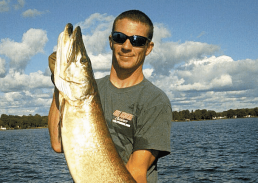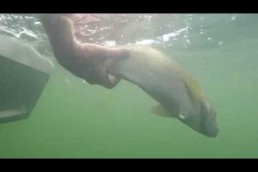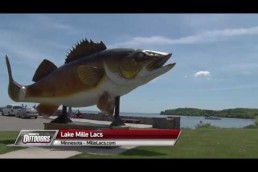Targeting Bass and Muskies on Mille Lacs Lake
SHARE THIS POST
Central Minnesota’s Mille Lacs Lake is a true multi-species gem, featuring walleyes, smallmouth bass and muskies. You can also target some monster bluegills and slab crappies in the shallow bays of this massive body of water, measuring 207 square miles and over 132,000 acres.
This is a shallow fishery with a maximum depth of only 40 feet. With only a few tiny islands nestled near the lake’s south shore, the state’s second-largest lake features vast expanses of open water and a mud basin dominated by walleyes.
Nearer to the shorelines, numerous shallow, rock reefs (most well below the surface with hazard areas well-marked by buoys) comprise the dominant structure and provide prime habitat for prized smallmouths. Anglers from far and wide know this lake is considered one of the top smallie destinations in North America. It’s no accident that B.A.S.S. has chosen Mille Lacs as the location to host the 2016 Angler of the Year Championship in September. The main draw is huge numbers of quality fish, including many 20-inch brutes.

While the bass fishery remains steady throughout the open-water season, the bite in June can be nothing short of spectacular. Seasoned Mille Lacs anglers commonly catch and release 50-plus fish during a good day with an average size above 17 inches.
Dean Fisher, who owns Fisher’s Resort in the northeast corner of the lake, has been guiding and skippering charter launch boats here for over 25 years.
“The Mille Lacs bass fishery is both a numbers and size thing,” Fisher said. “Even unskilled anglers can catch 20-plus fish easily on a good day.”
Fisher likes throwing soft plastics for May and June bass—either a smoke- or brown-colored grub with a twister tail rigged on a swim head or a simple tube. Smoke and green/red flake are his favorite tube colors.
Noted Mille Lacs guide and MWO contributor, Tony Roach, also likes throwing tubes.
“When fishing tubes, slow is the key,” Roach says. “Too many anglers tend to pull up to the reefs and power-fish the entire area and then boogie out of there. You’ll catch fish that way, but a better strategy is to use your electronics to zero in on the sharpest breaks with the biggest boulders on these reef structures. He added that often, the largest bass will be tight to the biggest boulders on the reefs, and they hold near that structure and forage on crayfish after the spawn.
Are you enjoying this post?
You can be among the first to get the latest info on where to go, what to use and how to use it!
“Don’t be afraid to try finesse plastics for these fish,” he said. “You might think a 4-inch tube catches big bass, but sometimes a little 2-inch bait works better.”
With crystal-clear water clarity—the result of invasive zebra mussels that filter plankton from the water—sight fishing is a true joy on sunny calm days in the early season. You’ll spot big bass cruising along the tops and edges of the rock reefs. Jerkbaits, small cranks that can be retrieved with an erratic bounce through the boulders and topwater lures are all productive options.
The Lake Mille Lacs muskie fishery is renowned as a big-fish destination, although in recent years the numbers of fish seen by anglers during a day of muskie fishing seems to have diminished.
Fisher speculates that the growth of these fish has altered their movement patterns. He says that some of the biggest “girls” in the lake aren’t in the shallows now as frequently as they were when they were younger.
“For years, you could spend a day casting the weed edges and see numbers of fish; you’d get lots of follows. The fishery has evolved and a lot of the big fish spend the majority of their time suspended in open water. They are pelagic. Sure, you’ll move some fish by casting in the shallows and in the fall there are big fish crawling all over the reefs feeding on tullibees, but for a lot of the season, the fish are in the basin,” he added.
Some of Fisher’s go-to lures for casting in June and July are black-and-orange bucktails, number 10 Rapala BX Minnows (Blue Pearl, Silver, Smelt) and large-profile white swimbaits. For trolling, he had good luck last year with Mullet and Hot Tiger Super Shad Raps. (Note: You can catch some big northern pike incidental to the muskies when fishing on Mille Lacs.)
Also, if you’re bass fishing on the reefs here, be sure to rig up a rod with a muskie bucktail and have it handy. There’s always a chance you’ll spot a big fish cruising the reefs in the sunshine and you might have a chance to turn her head with a couple of well-placed casts.
This year’s Angler of the Year Championship will have the spotlight focused on central Minnesota even more. Mills Lacs Lake always offers some of the best fishing in the Midwest.
MWO
SHARE THIS POST
Did you enjoy this post?
You can be among the first to get the latest info on where to go, what to use and how to use it!



